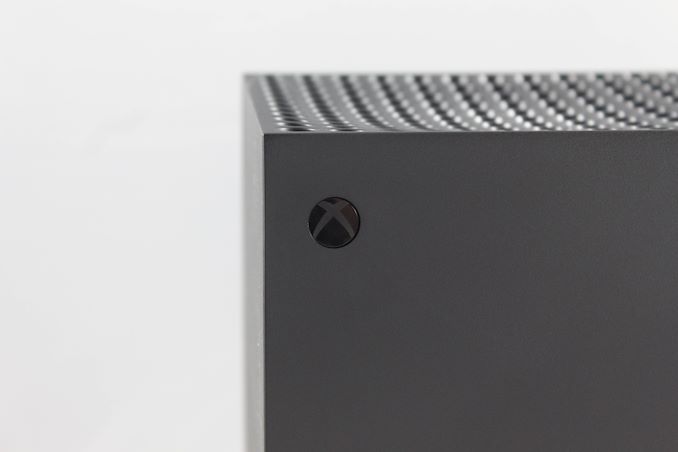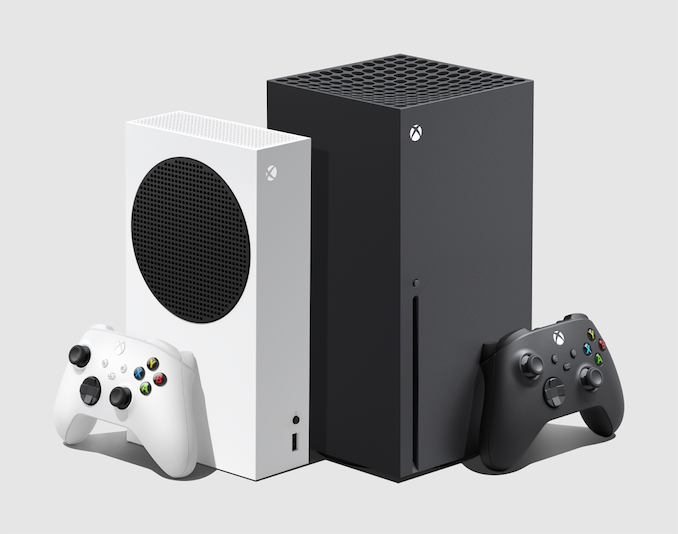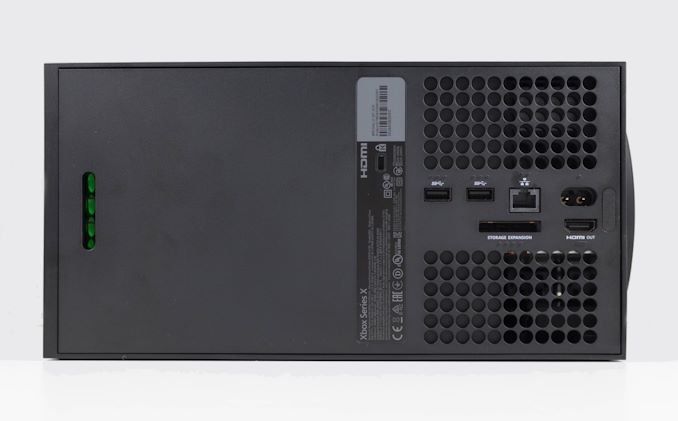The Xbox Series X Review: Ushering In The Next Generation of Game Consoles
by Brett Howse on November 5, 2020 9:00 AM EST
What makes a console generation? The lines have been blurred recently. We can state that the Xbox Series X, and its less-powerful sibling, the Series S, are the next generation consoles from Microsoft. But how do you define the generation? Just three years ago, Microsoft launched the Xbox One X, the most powerful console in the market, but also with full compatibility with all Xbox One games and accessories. With multiple tiers of consoles and mid-generation refreshes that were significantly more powerful than their predecessors – and in some cases, their successors – the generational lines have never been this blurred before.
None the less, the time for a “proper” next generation console has finally arrived, and Microsoft is fully embracing its tiered hardware strategy. To that end, Microsoft is launching not one, but two consoles, with the Xbox Series X, and the Xbox Series S, each targeting a difference slice of the console market both in performance and price. Launching on November 10, 2020, the new Xboxes bring some serious performance upgrades, new designs, and backwards compatibility for not only the Xbox One, but also a large swath of Xbox 360 games and even a good lineup of games from the original 2001 Xbox. The generational lines have never been this blurred before, but for Microsoft the big picture is clear: it’s all Xbox.
The Xbox Series X is the flagship console, and the one we have been teased about for over a year. When launched, it will be the most powerful console in the market. Microsoft learned some lessons from the original Xbox One launch, and they seem keen to not make those mistakes again, so they have partnered with AMD to deliver a console with eight Zen 2 CPU cores paired with an AMD RDNA 2 graphics processor with 12 TFLOPS of performance. With 16 GB of GDDR6 memory, and 1 TB of solid-state storage, the new Xbox Series X targets gamers looking for 4K gaming at 60 FPS, with up to 4K 120 FPS on some titles.
The Xbox Series S goes a different route, with a much more cost-effective console. It still features AMD Zen 2 CPU cores, but a much smaller 4 TFLOP GPU, which is not even as powerful as the Xbox One X from 2017. With 10 GB of GDDR6 and 512 GB of solid-state storage, the Xbox Series S targets 1440p gaming, or, more realistically for televisions, 1080p at up to 120 FPS, and with a large number of people still owning 1080p televisions, the less-expensive console has a definite niche.
Both consoles offer solid-state storage, which is one of the key features of the new generation. While not a new idea, solid-state offers a significant number of performance benefits as have been realized in the PC space for a decade or more, but cost has been prohibitive before.
With any console generation, the glue that holds it together is the games, and Microsoft has chosen a very different course for the Xbox Series X|S. With full backwards compatibility, there is already a large library of games, and games developed for the new consoles will continue to be available on the Xbox One as well, at least for now. Exclusives that are just for the Xbox Series X|S do not exist, which is certainly not how most console launches go. Instead, Microsoft sees the future of gaming in the Xbox Game Pass, which is a subscription service to a buffet of gaming titles.
| Xbox Specification Comparison | ||||||||||||||
| Xbox Series X | Xbox Series S | Xbox One X | Xbox One S | |||||||||||
| CPU Cores | 8C/16T | 8C/16T | 8C/8T | 8C/8T | ||||||||||
| CPU Frequency | 3.8 GHZ 3.6 GHz w/SMT |
3.6 GHZ 3.4 GHz w/SMT |
2.3 GHz | 1.75 GHz | ||||||||||
| CPU µArch | AMD Zen 2 | AMD Zen 2 | AMD Jaguar | AMD Jaguar | ||||||||||
| GPU Cores | AMD RDNA 2 52 CUs 3328 SPs 1.825 GHz |
AMD RDNA 2 20 CUs 1280 SPs 1.565 GHz |
AMD GCN 2 40 CUs 2560 SPs 1172 MHz |
AMD GCN 2 12 CUs 768 SPs 914 MHz |
||||||||||
| Peak Shader Throughput | 12 TFLOPS | 4 TFLOPS | 6 TFLOPS | 1.4 TFLOPS | ||||||||||
| Embedded Memory | None | None | None | 32MB eSRAM | ||||||||||
| Embedded Memory Bandwidth | None | None | None | 218 GB/s | ||||||||||
| System Memory | 16GB GDDR6 | 10GB GDDR6 | 12GB GDDR5 | 8GB DDR3-2133 | ||||||||||
| System Memory Bus | 320-bit | 128-bit | 384-bit | 256-bit | ||||||||||
| System Memory Bandwidth | 10 GB @ 560 GB/s 6 GB @ 336 GB/s |
8 GB @ 224 GB/s 2 GB @ 56 GB/s |
326 GB/s | 68.3 GB/s | ||||||||||
| Storage | 1 TB SSD 802 GB Free |
512 GB SSD 364 GB Free |
1 TB HDD | 500 GB HDD | ||||||||||
| Manufacturing Process | TSMC 7nm | TSMC 7nm | TSMC 16nm | TSMC 16nm | ||||||||||
| Dimensions | 151mm x 151mm x 301mm | 151mm x 275mm x 65mm | 300mm x 240mm x 60mm | 295mm x 230mm x 65mm | ||||||||||
| Weight | 4.44kg | 1.92kg | 3.81kg | 2.9kg | ||||||||||
| PSU | 315W (Internal) |
165W (Internal) |
245W (Internal) |
120W (Internal) |
||||||||||
| Optical Drive | UHD Blu-Ray | None | UHD Blu-Ray | UHD Blu-Ray | ||||||||||
| Wireless | 2x2 802.11ac | 2x2 802.11ac | 2x2 802.11ac | 2x2 802.11ac | ||||||||||
| Launch Price (USD) | $499 | $299 | $499 | $299 | ||||||||||
| Launch Date | 11/10/2020 | 11/10/2020 | 11/07/2017 | 08/02/2016 | ||||||||||
Microsoft has blurred the generational lines significantly with the Xbox Series X|S launch in quite a few ways, and accessory support is definitely one of them. In past console generations, new consoles would have new controllers and all new accessories would be required. That is not the case with the Xbox Series X|S. All Xbox One controllers are 100% compatible, as should be most other accessories such as headphones, and even the Xbox Adaptive Controller. There is one major accessory which is not compatible though, and that is Kinect. Kinect was a major focus of the Xbox One launch, but Microsoft quickly dropped the expensive accessory from being a requirement, and its use-case never materialized in any significant way. Xbox One games that require Kinect will not be compatible with the new Series X|S but all other Xbox One games will be through backwards compatibility. If you still use Kinect and enjoy it, this may seem like a step back, but from personal experience, Kinect will not be missed.
Another loss moving into this generation is the HDMI input which is no longer available. As part of the media push for the Xbox One, it included an HDMI input so you could insert the Xbox between your cable box and TV, allowing cable to be controlled via an IR blaster which could be plugged into the Xbox One. This had some advantages, but the media usage with DVR recording functionality ultimately never materialized, and there were likely only a small group of people taking advantage of this feature.
With the console features that define generations a short list indeed, let us now dig into the technical specifications of the new consoles so we can determine if these are indeed generational updates.












68 Comments
View All Comments
marees - Saturday, November 7, 2020 - link
I would need 3 things to buy this console:1. Releasing Flight Simulator for console
2. Allowing to install xcloud app on console
3. A more universal release of All Access plans (for all countries)
Basically I would like to play the Flight Simulator without having to install it (or a huge download)
cmdrdredd - Monday, November 9, 2020 - link
Sony is doing a pretty terrible job with the PS5 so I don't know where you get that idea from. They botched the pre-order launch, hid a lot of details about backwards compatibility, don't support VRR at launch, and have a weaker system overall. It'll sell out because of the popularity of the brand alone but the Series X is the top console this time around.FunBunny2 - Thursday, November 5, 2020 - link
sure looks like a Mac Trashcan. I expect MS hopes this thing works out better.vailr - Friday, November 6, 2020 - link
How difficult will it be to install an alternative operating system on the X-Box Series X? It seems to be compatible with running either macOS or Windows, if the bios firmware can be altered sufficiently to allow booting into another O.S.. Interesting to see what happens.tkSteveFOX - Friday, November 6, 2020 - link
I really don't see the point of having an 8/16 CPU in the S. Why didn't they cut it to 6/12 to save some space/thermals?That GPU in there is totally a bottleneck for the CPU.
I'm sure fans would have wanted a slightly better GPU in favour of the 8 core CPU with 16 threads.
I just find it illogical as a choice.
Brett Howse - Friday, November 6, 2020 - link
If they drop that too far, games that have the same visual elements (think a busy city street with a lot of NPCs) might not be possible on the Series S which would mean that the developer would just target the lowest common denominator. It makes a lot of sense why they have kept the CPU similar.jabber - Friday, November 6, 2020 - link
Also might be some 'currently locked' potential they can free up at a later date as a bonus.eastcoast_pete - Friday, November 6, 2020 - link
Also, I would be amazed if MS doesn't use the Series S to "reduce, reuse, recycle" the APUs that didn't make the cut for the Series X, but work okay at lower speed. There are several "bins" before the one labeled "garbage".eastcoast_pete - Friday, November 6, 2020 - link
Looking again at the specs, that "recycle" might also apply to the GDDR6 in the series S. That memory bandwidth really gimps the S; I think that was a mistake, with a slightly wider bus and even half the bandwidth of the Series X, it could have been a contender (yes, that old Rocky quote).FunBunny2 - Saturday, November 7, 2020 - link
"yes, that old Rocky quote"young-un!!!
"I coulda' had class. I coulda' been a contender. I coulda' been somebody. Instead of a bum, which is what I am."
-- Terry Malloy/Marlon Brando 'On The Waterfront' 1954